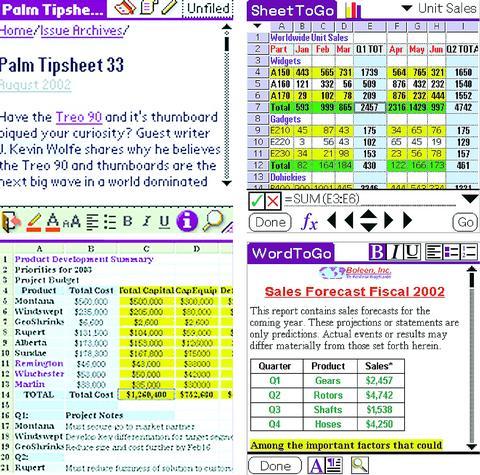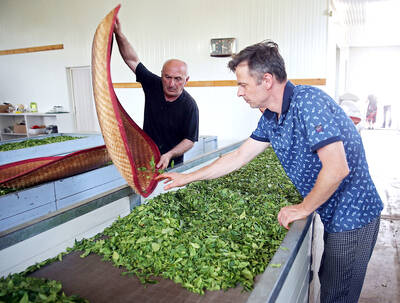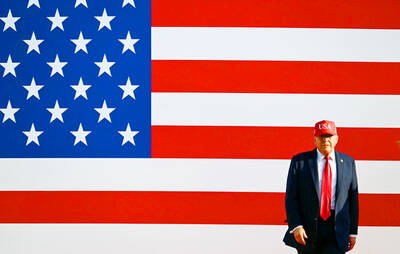Any glamour associated with toting around laptop computers has long since vanished. With their bulk, their attractiveness to thieves and the complications they bring to airport security checks, many travelers would just as soon leave them at home.
The rise of e-mail accounts that can be checked through any Web browser has liberated some people, too. Even when on the road for work, they use Internet cafes, copy shops with rental computers or even clients' computers to check their e-mail.

PHOTO: NY TIMES
That method doesn't work for those whose on-the-road computing needs go beyond keeping their in-boxes under control or glancing at a Web site. Even the heftiest laptop becomes a welcome travel companion if the alternative is spending hours writing reports in an around-the-clock copy shop.
There may be, however, an alternative for people with broader computing needs, in the form of the laptop's little sibling, the hand-held organizer, or palmtop. The wide availability of snap-in keyboards, software that can move documents from Microsoft Office and from other software packages, and the growing variety of palmtops that offer expandable memory potentially make palmtops a laptop alternative.
It doesn't take much research to know that exchanging a fully featured laptop for a pocket-size computer and folding keyboard involves some compromises. To determine whether it was worth the effort, I tried several software packages using both of the main operating systems for hand-helds -- Palm OS and Microsoft PocketPC -- and three different palmtops with varying features and prices.
Most palmtops don't lead independent lives. While some wireless models offer Internet connections, palmtops generally rely on synchronizing with a full-size computer through a cradle to receive or forward files. The need to connect occasionally with a bigger computer limits the ability of hand-helds to replace laptops on extended trips. And, of course, the trade-off for carrying a computer slimmer than a deck of cards and smaller than a paperback novel is that it doesn't have the computing power of a full-size machine.
But even after accounting for the purchase of a snap-on keyboard that unfolds like a mechanical butterfly, or extra memory, most hand-helds cost considerably less than a typical laptop. Similarly, palmtop software is generally less expensive than programs for a personal computer.
Only the PocketPC operating system offers the ability to create or edit documents in standard formats -- at least if they are Microsoft Word and Excel files. While Microsoft doesn't throw in Word and Excel with Windows, it includes the palmtop versions of the software at no extra cost on all PocketPC hand-helds.
Microsoft Pocket Word's formatting options are so limited that the program might be better called a text editor than a word processor. But both Pocket Word and Pocket Excel worked quickly when I tried them on a Toshiba e755, a recently introduced hand-held with a suggested price of US$599. And for users of hand-helds with wireless connections to the Internet (the e755 can work on Wi-Fi networks), PocketPC can send, receive and open e-mail attachments of Word or Excel files without ever synchronizing its contents with a desktop PC through a cradle.
Because palmtops with the Palm operating system usually aren't supplied with anything like Pocket Word, many owners make do by cutting and pasting text from Memo Pad, Palm's basic text editor, into Word after the Palm contents have been synchronized with a desktop computer. Any formatting must be done on the larger computer. Still, for people who only rarely use their palmtops for writing or editing, Memo Pad is certainly economical.

When Lika Megreladze was a child, life in her native western Georgian region of Guria revolved around tea. Her mother worked for decades as a scientist at the Soviet Union’s Institute of Tea and Subtropical Crops in the village of Anaseuli, Georgia, perfecting cultivation methods for a Georgian tea industry that supplied the bulk of the vast communist state’s brews. “When I was a child, this was only my mum’s workplace. Only later I realized that it was something big,” she said. Now, the institute lies abandoned. Yellowed papers are strewn around its decaying corridors, and a statue of Soviet founder Vladimir Lenin

UNIFYING OPPOSITION: Numerous companies have registered complaints over the potential levies, bringing together rival automakers in voicing their reservations US President Donald Trump is readying plans for industry-specific tariffs to kick in alongside his country-by-country duties in two weeks, ramping up his push to reshape the US’ standing in the global trading system by penalizing purchases from abroad. Administration officials could release details of Trump’s planned 50 percent duty on copper in the days before they are set to take effect on Friday next week, a person familiar with the matter said. That is the same date Trump’s “reciprocal” levies on products from more than 100 nations are slated to begin. Trump on Tuesday said that he is likely to impose tariffs

HELPING HAND: Approving the sale of H20s could give China the edge it needs to capture market share and become the global standard, a US representative said The US President Donald Trump administration’s decision allowing Nvidia Corp to resume shipments of its H20 artificial intelligence (AI) chips to China risks bolstering Beijing’s military capabilities and expanding its capacity to compete with the US, the head of the US House Select Committee on Strategic Competition Between the United States and the Chinese Communist Party said. “The H20, which is a cost-effective and powerful AI inference chip, far surpasses China’s indigenous capability and would therefore provide a substantial increase to China’s AI development,” committee chairman John Moolenaar, a Michigan Republican, said on Friday in a letter to US Secretary of

Taiwan Semiconductor Manufacturing Co’s (TSMC, 台積電) market value closed above US$1 trillion for the first time in Taipei last week, with a raised sales forecast driven by robust artificial intelligence (AI) demand. TSMC saw its Taiwanese shares climb to a record high on Friday, a near 50 percent rise from an April low. That has made it the first Asian stock worth more than US$1 trillion, since PetroChina Co (中國石油天然氣) briefly reached the milestone in 2007. As investors turned calm after their aggressive buying on Friday, amid optimism over the chipmaker’s business outlook, TSMC lost 0.43 percent to close at NT$1,150